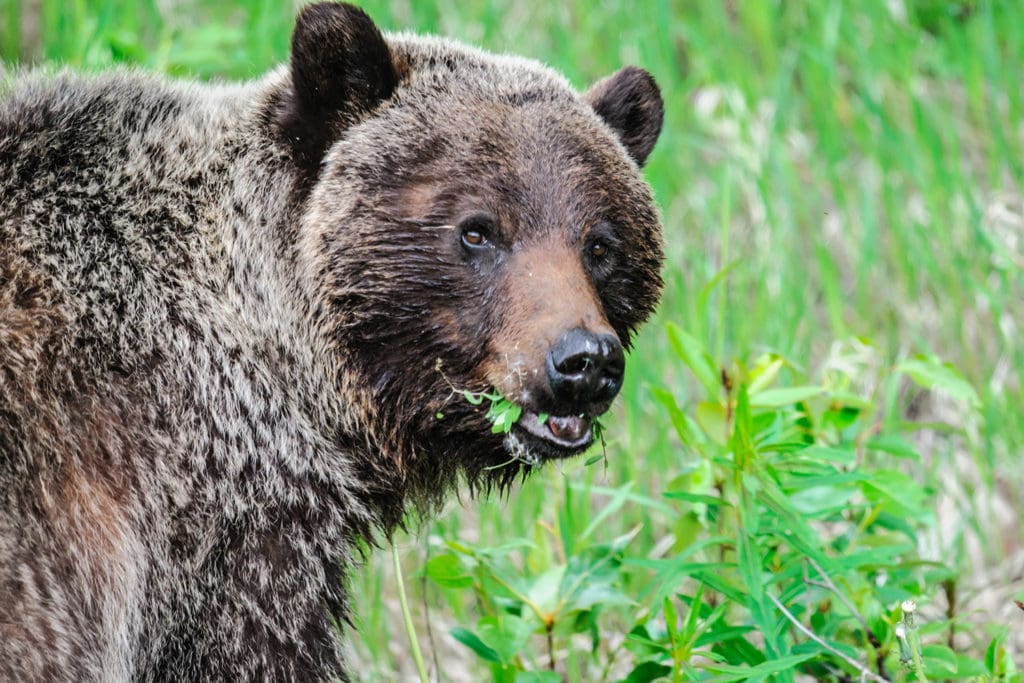We need thriving wild places.
Wild places provide us with the things that keep us alive: fresh water, clean air, productive soil, and protection from natural disasters like drought and floods.
When animals, birds, fish, plants, soil and water interact as they should, not only does wildness thrive — so do we.
To know how well our wild spaces are faring, we often turn to the grizzly bear. Due to their need for large, intact landscapes and diverse ecosystems, grizzly bear populations are good indicators of the health of our natural landscapes. When bear populations thrive, our wild places are healthy.
Issue: Bad News Bears
Unfortunately, the status of North America’s grizzlies tells us that all is not well. More than 100,000 grizzly bears once roamed from Mexico to Alaska.
By the 1920s, many grizzly populations were exterminated, leaving only island populations in western United States. By the early 1970s, grizzly bears in the Greater Yellowstone Ecosystem were completely cut off from the remaining bears on the continent, stranding them on an island of habitat where, even today, their future survival is at risk.
Other species such as caribou, wolverine and bull trout share a similar story.
Cause: Habitat Fragmentation
The problem is not only habitat loss but how that loss occurs: big pieces of wild land get chopped into ever-smaller chunks until the wide-ranging grizzlies and other wildlife encounter too many manmade obstacles to survive. This process is known as habitat fragmentation.
Roads, development and settlement break up the landscape, reduce the amount of wildlife habitat and bring bears into frequent contact with people, often leading to bear deaths.
When bear populations lose their ability to connect with other bear populations, inbreeding ensues and the gene pools weaken.
Even with 44 national parks scattered throughout the Yellowstone to Yukon region, protected areas alone are not big enough to ensure the long-term survival of this umbrella species.
The Big Unknown: Climate Change
More than 95 per cent of climate scientists agree that human-caused climate change is occurring. This is disrupting biological relationships that have evolved since the last ice age.
Wildlife and plants depend on certain temperatures to survive. As a result, many species will need to adapt – or perish.
Within the Yellowstone to Yukon region, we have already experienced extreme events and precipitation is projected to shift from snow to rain. Glaciers are melting, increasing the likelihood of spring floods and summer droughts.
These changes will cause plant communities and wildlife to move in search of more favorable climates. Pikas and wolverines, for example, will move to higher elevations and more northern habitat to find the cooler temperatures they need to survive. Even entire ecosystems will shift.
In northern British Columbia it is expected that some alpine ecosystems found at higher elevations will be taken over by scrubby plants and trees from lower down. Animals that live above treeline will be squeezed out. Although, large lakes and streams should remain, small shallow ones could dry up or fill in.
The best solution to support these inevitable changes is to maintain and connect large swaths of ecologically diverse land, like those found in the Yellowstone to Yukon region.
Solution: Think Big
In 1993, a group of conservationists, scientists and activists met to discuss a solution to habitat fragmentation. Their idea was to think of conservation on a larger scale — a continental scale.
Their vision was of a web of life-sustaining wildlife habitats linked by movement corridors that extend some 2,100 miles (3,400 kilometers) from Yellowstone National Park to the Yukon Territory.
It is a vision that seeks to reverse fragmentation; to protect and connect habitat in order for wildlife and people to coexist and thrive. Such a protected and connected network also creates the best opportunity for wild species to move to adapt to a changing climate.
The Yellowstone to Yukon Conservation Initiative (Y2Y) exists to realize this vision.
A Global Model
Today, Y2Y‘s continental-scale conservation strategy is recognized as a global model for reconciling the needs of nature and people.
A few years after the Yellowstone to Yukon vision was launched, the Panel on Ecological Integrity of Canada’s National Parks hailed this scale of conservation the “new paradigm of protected areas.”
In 2011, Y2Y was featured in President Obama’s America’s Great Outdoors report as a leading example of a collaborative approach to large-landscape conservation.
Not only does this big-picture approach remedy genetic isolation and the loss of habitat, scientists also believe it is the appropriate scale for enabling wildlife and vegetation to adapt to the environment’s most pressing issue — climate change.


